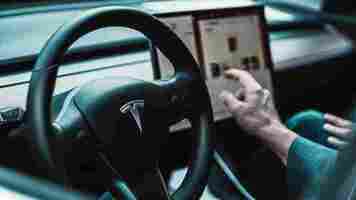Finland proposes EV subsidies for women. Here’s why it’s a bad idea
We saw an intriguing piece of news this morning, as reported in Euractiv. The Finnish environmental ministry is discussing the idea of a temporarily lower vehicle tax or subsidy for women buying electric cars.

Finland currently has a €2,000 ($2260) purchase subsidy from the Finnish government (with a maximum price of €50,000 or $56,000) for people buying a new electric car or signing a long-term lease agreement for an electric vehicle.
This proposal leaves me with more questions than answers. Let’s take a look:
Do women face gender discrimination in car buying?


It’s worth remembering that many women have bad experiences making big-ticket purchases.
Women historically have many negative experiences of being treated differently based on gender at show salerooms and repair shops. Being the buyer but being ignored for your male companion is a common example. No matter the money you plan to spend.
I even remember visiting one showroom (as a journalist) whereupon asking details about functionalities and price, a salesperson asked if I was “spending my man’s money or if it was a gift from my father.” “Ah, no, I write about cars as a tech journo” I replied, only to see him wince and leave the room…
Online buying creates more egalitarian business models
Fortunately, EV companies like Tesla are changing this through their online buying. There’s no need to deal with a sleazy salesperson anymore. Especially the kind who asks what color car you want before anything else.
There’s also plenty of research opportunities online. For example, forums and Twitter, where (whether you expose your gender or not) you can ask critical questions and get a diverse range of feedback.
I see many women car nerds proudly discussing the minutiae of EVs and cars, in general, every day on social media. It’s not just guys that are into cool design, speed, and engines.
We’re still trotting out the same old stereotypes about women
2018 research into EV buying was conducted by the University of Sussex and Aarhus University in Denmark. It found that highly educated women are an untapped but potentially lucrative market because they have greater environmental and fuel efficiency awareness than men.
The study was based on a survey distributed to 5,000 people across Denmark, Finland, Iceland, Sweden, and Norway.
It found that women drive fewer kilometers per day, expect to pay less for their next car, and have considerably less experience of driving electric vehicles than men.
The research stressed that occupation and employment also influence stated preferences, with those working for non-profit organizations most likely to own electric vehicles, and academics at universities most associated with interest in owning an electric vehicle.
It also found that men give more importance to speed, acceleration, design, and style when choosing a car. At the same time, women rank ease of operation, safety, running costs, and environmental impact — making electric vehicles a better fit for their specifications.
That’s a whole lot of time and money devoted to stereotypes. So highly educated women are likely to be more environmentally friendly? Well, highly educated women are likely to have more money.
We all know the cost of organic food and sustainable fashion vs. fast fashion. And surely safety is more of a concern as you are more likely to be transporting children and grandchildren? Hardly a no-brainer.
Isn’t the bigger idea to get people using EVs over ICEs?
Is Finland trying to get women to switch from ICEs to EVs or to buy an EV for their first car? I’m not clear on the logic.
A transition to EVs is inevitable as gas vehicles phase out over the next five years. Therefore, subsidies are likely to become less of an issue for new buys. Simply put, if your only choice is an EV, then you will buy an EV.
The bigger challenge is a low-income status, not just gender
People in low-income jobs are more likely to work third shifts, which are not conducive to using public transport. They more commonly live further away from work. This makes public transport time prohibitive.
It is harder to find cheap electric vehicles than gas vehicles. This means that people who will only ever own second-hand cars risk permanent exclusion from access to electric vehicles.
Further, low-income earners are the hardest hit by ICE owner disincentives. These include city tolls , harder-to-access parking, and other disincentives.
Plus, low-income earners are also more likely to live in apartments without off-street parking. This means they are excluded from the benefit of cheaper, more accessible charging , and forced to rely on higher-priced public charging stations.
Range anxiety and safety is a reality
Range anxiety is real for low-income earners, especially if you live in an area without private access to EV charging and a lack of close public EV charging stations .
And let’s not forget, women are rightly concerned about range anxiety and safety. A woman’s car running out of steam on a dark, deserted road, could be a catalyst for an opportunistic attack, especially with kids in tow.
We see two dichotomies at play. On the one hand, researchers see high-income women as the untapped EV target market. On the other hand, the Finnish government proposes EV subsidies for women, and mind you, these subsidies do nothing to help low-income women enter the EV market in the long term.
Thus, a gender-based grant is more of an attempt at greenwashing than an effort to address financial inequality and only increases gender division among EV buyers . Overall, a subsidy may help someone with enough income to buy an EV, but it fails to identify or address the income disparity experienced by many women.
Look ma, no hands: people don’t understand how to use driver-assist systems safely
Adaptive cruise control , lane change assistance , collision avoidance , blind spot monitoring , autopilots : These are just a few of the driver-assist features that are arriving in new cars. As technology races ahead with the aim of making driving safer, drivers are left with the daunting task of figuring out how it all works.

Many dealerships offer car buyers a brief orientation to these advanced driver-assist technologies. The glovebox manual, now thicker than ever, provides many of the technical details. But as car technology continues to advance, scientists are making important discoveries about the human side of the equation, particularly what happens when drivers are asked to perform familiar driving tasks in new ways.
This aspect of new cars is seldom discussed during orientations or covered in manuals. Here are some findings about using advanced driver-assist technologies that every driver should know.
Staying alert
A recent study that observed new car owners during their first month of ownership found that drivers paid close attention as they acquired a sense of what their driver-assist systems can and cannot do. But by the end of the month, many drivers began to allow their attention to drift from the road in uncomplicated driving situations – seemingly impossible-to-get-wrong scenarios such as open stretches of highway.


It may sound harmless enough, but here’s the catch: While an open stretch of road seems safe to a human, it can sometimes push the car’s computer vision system to its limits and beyond.
That’s why the federal government opened an investigation into Tesla’s Autopilot driver-assist technology after 11 Teslas being operated on Autopilot smashed into police cars and firetrucks that had their emergency lights flashing.
Computers don’t see and understand the world as humans do. Sure, today’s artificial intelligence systems can beat the world’s greatest chess masters, but they can also miss a flashing firetruck that’s sitting right in front of them. We humans draw upon a powerful and flexible commonsense understanding of the world. Our cars possess nothing like that . They know the world as data compiled from video footage.
With that in mind, how do you know when to relax and when to be nervous while using a driver-assist system? The short answer is that you don’t.
The hazard detection systems in your new car are designed for those rarest of occasions in which something eludes your watchful eye. But studies of drivers tell us that, after a time, many begin to rely on these systems as more than a backup. One recent study documented that drivers looked at the road less often and focused their attention on non-driving areas more often while using Tesla’s Autopilot system.
Without even realizing it, and slowly over time, simply knowing that a backup system exists can coax people into letting down their guard. In the most extreme cases, listening for an alarm to sound can become some people’s primary means of detecting a hazard. So instead of having two entities watching the road, it’s down to one.
Shared driving is hard work
Maybe you are the type of driver who commits yourself to paying attention at all times, no matter how capable your car may seem. It turns out that watching a computer drive your car is harder than it looks.
What seems like a leisurely activity at first can be oddly tiring . It’s hard to keep your mind focused on what’s happening in front of you – especially along familiar routes and when all is going as expected. Prolonged sitting and staring , waiting for improbable disaster to strike, is not something that humans are naturally good at.
It’s hard to imagine ever pushing an autopilot button and taking a nap like those drivers you’ve seen on the evening news , but here is where misunderstanding strikes again. Did these drivers plan to take a nap or did it just happen?
To find out, researchers in another study outfitted drivers with brain and vision monitoring systems and found that drivers who used the autopilot were more likely to drift into early stages of sleep without ever realizing it. Today’s busy schedules can cause a great many people to accumulate sleep debt . People tend to fight off that sleep debt by staying busy. But pushing a button and freeing yourself from the activity of driving may give that lurking sleepiness an opportunity to catch up and overtake you.
Literal and figurative blind spots
Your new rearview camera seems like a lifesaver. It allows you to see into your worst blind spot. But a study of drivers using these cameras found something unsettling. Having the cameras prompts many drivers to skip the traditional over-the-shoulder checks . What these drivers generally don’t realize is that back-over crashes unfold over time and often begin to the side of a car. For example, kids can run out of a house and around the back of a car to say goodbye to the driver.
When you swivel your head around to the back in addition to checking the camera, you see it all. You can catch the beginning and the middle of these unfolding events, and then ensure a safe ending. But among a population of drivers who may not understand this, another study estimated that rearview cameras only reduce back-over crashes by about 17% despite largely eliminating the rear blind spot.
A new kind of driver training
Driver assistance systems are powerful tools that promise to save a great many lives, but they will require people to adjust their understanding of a familiar driving task to align with one that is new and different in important ways. The challenge is getting everyone to make that adjustment, and there are 250 million drivers in the U.S. alone.
My colleagues and I have pushed for standardized training for new car buyers that includes the human element of partially automated driving . Part of the challenge is having to approach drivers with some fairly counterintuitive ideas.
Imagine suggesting to someone that they don’t understand the difference between a safe situation and a dangerous one, or that they really don’t know when they are tired, or that watching a car drive itself is more tiring than driving. For many drivers, this advice might not sink in when they first use driver-assist technologies. It may take some profound and personal reconsideration of what you think you know.
And what about the youngest drivers, the ones who account for a disproportionate number of crashes ? More than a decade after driver education was virtually eliminated from high school curricula, along came smartphones, apps and now driver-assist technologies. It might be a good time to start teaching some new safety concepts, in the classroom if not behind the wheel of a car.
For now, after you’ve learned to push the buttons and interpret the displays in your new car, keep in mind that there is more to using these technologies than meets the eye.
This article by Steve Casner , Research Psychologist, NASA , is republished from The Conversation under a Creative Commons license. Read the original article .
Mini joins the EV restomod craze with reversible conversions
During the past few years, there’s been a flurry of electrified classic vehicle unveilings from newly launched independent firms, such as Lunaz , Electric Classic Cars , and Electrogenic , as well as an array from automotive giants.

The latest carmaker that’s putting an electric motor into a classic model is Mini.
The idea was born when the brand showcased a one-off classic Mini Electric at the New York Autoshow back in 2018.
According to the company , the reactions were so positive that now a team of e ngineers at MINI’s Oxford plant have devised an EV conversion package for the iconic hatchback to create the Mini Recharged — available to customers who own a classic Mini.


The Recharged conversion replaces the combustion engine with a 90kW electric motor and a battery pack. The restomod can go from zero to 60mph in nine seconds and its range is good for about 160 kilometers.
While the retrofit is primarily mechanical with no alterations to the car’s exterior or interior design, each electrified classic Mini will receive a bespoke central instrument cluster — now displaying drive temperature, selected gear, range, and speed.
Mini highlights that all changes are reversible. During conversion, the engine is marked and stored at the facility, which makes it possible t o restore the classic Mini to its original condition at a later date.
Personally, I don’t see the reason why one would want to reuse the original stinky engine , but I guess having the option to change your mind is a good selling point.
And perhaps that’s why Jaguar is following the same approach with its E-Type Zero Reborn .
With one in five new Mini models currently electrified, the company believes its Recharged program fits well into the brand’s future strategy, allowing classic Minis to have second, more sustainable life.
And as for the Mini owners who’ll opt for the conversion package, they won’t need a new car registration and will be able to hit the low-emission driving zones of many large cities inside an iconic classic.
Yes, that’s pretty cool.
There’s no word on the price tag yet, but specialist conversion companies such as London Electric Cars are electrifying Minis for about $40,000. Given that the Recharged is an official factory conversion, I expect the price will somewhat be more than that.